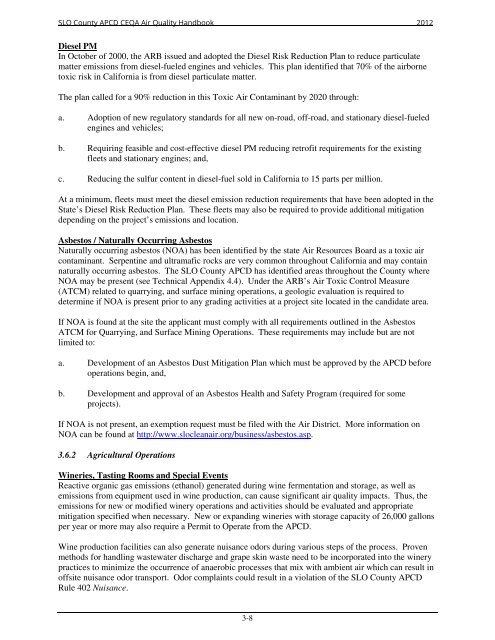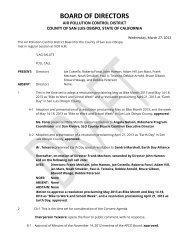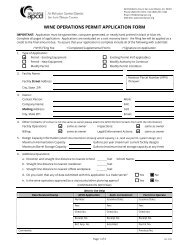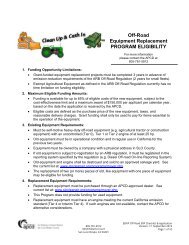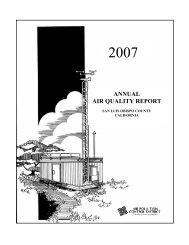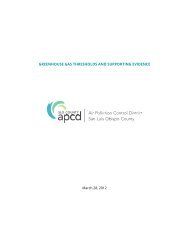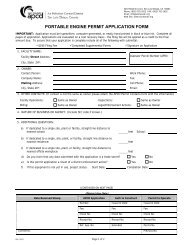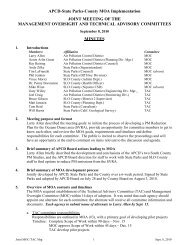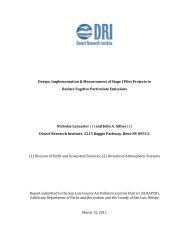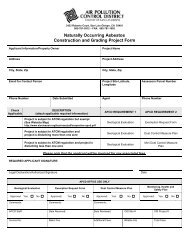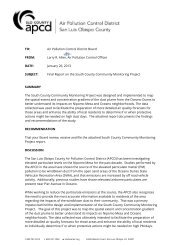CEQA Air Quality Handbook - Air Pollution Control District
CEQA Air Quality Handbook - Air Pollution Control District
CEQA Air Quality Handbook - Air Pollution Control District
You also want an ePaper? Increase the reach of your titles
YUMPU automatically turns print PDFs into web optimized ePapers that Google loves.
SLO County APCD <strong>CEQA</strong> <strong>Air</strong> <strong>Quality</strong> <strong>Handbook</strong> 2012<br />
Diesel PM<br />
In October of 2000, the ARB issued and adopted the Diesel Risk Reduction Plan to reduce particulate<br />
matter emissions from diesel-fueled engines and vehicles. This plan identified that 70% of the airborne<br />
toxic risk in California is from diesel particulate matter.<br />
The plan called for a 90% reduction in this Toxic <strong>Air</strong> Contaminant by 2020 through:<br />
a. Adoption of new regulatory standards for all new on-road, off-road, and stationary diesel-fueled<br />
engines and vehicles;<br />
b. Requiring feasible and cost-effective diesel PM reducing retrofit requirements for the existing<br />
fleets and stationary engines; and,<br />
c. Reducing the sulfur content in diesel-fuel sold in California to 15 parts per million.<br />
At a minimum, fleets must meet the diesel emission reduction requirements that have been adopted in the<br />
State’s Diesel Risk Reduction Plan. These fleets may also be required to provide additional mitigation<br />
depending on the project’s emissions and location.<br />
Asbestos / Naturally Occurring Asbestos<br />
Naturally occurring asbestos (NOA) has been identified by the state <strong>Air</strong> Resources Board as a toxic air<br />
contaminant. Serpentine and ultramafic rocks are very common throughout California and may contain<br />
naturally occurring asbestos. The SLO County APCD has identified areas throughout the County where<br />
NOA may be present (see Technical Appendix 4.4). Under the ARB’s <strong>Air</strong> Toxic <strong>Control</strong> Measure<br />
(ATCM) related to quarrying, and surface mining operations, a geologic evaluation is required to<br />
determine if NOA is present prior to any grading activities at a project site located in the candidate area.<br />
If NOA is found at the site the applicant must comply with all requirements outlined in the Asbestos<br />
ATCM for Quarrying, and Surface Mining Operations. These requirements may include but are not<br />
limited to:<br />
a. Development of an Asbestos Dust Mitigation Plan which must be approved by the APCD before<br />
operations begin, and,<br />
b. Development and approval of an Asbestos Health and Safety Program (required for some<br />
projects).<br />
If NOA is not present, an exemption request must be filed with the <strong>Air</strong> <strong>District</strong>. More information on<br />
NOA can be found at http://www.slocleanair.org/business/asbestos.asp.<br />
3.6.2 Agricultural Operations<br />
Wineries, Tasting Rooms and Special Events<br />
Reactive organic gas emissions (ethanol) generated during wine fermentation and storage, as well as<br />
emissions from equipment used in wine production, can cause significant air quality impacts. Thus, the<br />
emissions for new or modified winery operations and activities should be evaluated and appropriate<br />
mitigation specified when necessary. New or expanding wineries with storage capacity of 26,000 gallons<br />
per year or more may also require a Permit to Operate from the APCD.<br />
Wine production facilities can also generate nuisance odors during various steps of the process. Proven<br />
methods for handling wastewater discharge and grape skin waste need to be incorporated into the winery<br />
practices to minimize the occurrence of anaerobic processes that mix with ambient air which can result in<br />
offsite nuisance odor transport. Odor complaints could result in a violation of the SLO County APCD<br />
Rule 402 Nuisance.<br />
3-8


